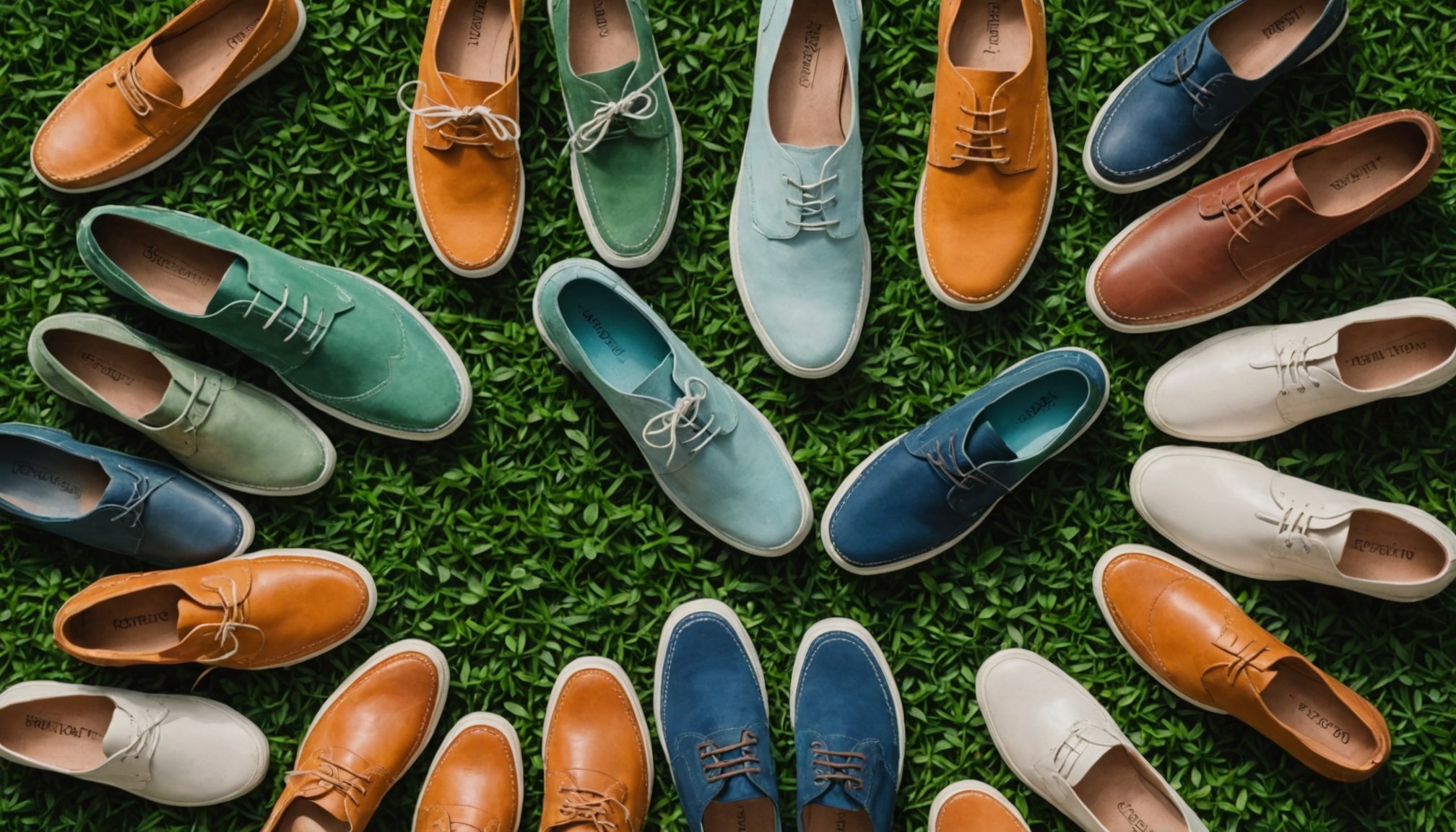Understanding Eco-Friendly Footwear
Eco-friendly footwear, also known as sustainable shoes or environmentally friendly footwear, is revolutionising the shoe industry with its focus on reducing environmental impact. These shoes utilise materials that are either recycled, biodegradable, or sourced responsibly, minimising harm to ecosystems. This approach contrasts sharply with traditional footwear, which often involves harmful practices like excessive water usage, chemical treatment, and poor biodegradability. Traditional methods contribute significantly to pollution and waste, as many shoes end up in landfills and release toxins.
The importance of eco-friendly footwear extends beyond just reducing harmful environmental practices. Sustainable shoes help mitigate the carbon footprint and waste associated with the production and disposal of traditional footwear. The demand for environmentally friendly footwear is growing rapidly. Consumers are becoming increasingly aware of their environmental impact, seeking out brands that offer greener options.
Also to see : Ultimate Guide: Must-Have Essentials for a Stylish Weekend Escape to the Lake District
The trend towards eco-friendly footwear is not just about sustainability; it also highlights ethical considerations. Companies are being held accountable for their sourcing and manufacturing processes. As the industry evolves, this trend signifies a shift in consumer expectations and a commitment to more sustainable living, fostering innovation in product design and material usage.
Key Materials Used in Eco-Friendly Footwear
In the pursuit of sustainability, eco-friendly footwear incorporates a variety of sustainable materials, each playing a crucial role in reducing environmental impact. Natural fibers, such as organic cotton, hemp, and bamboo, are popular for their low environmental footprint and biodegradability. Organic cotton, devoid of harmful pesticides, provides a comfortable and breathable alternative for shoe uppers. Hemp, known for its durability, requires minimal water and grows without synthetic fertilizers, making it a sustainable choice. Bamboo fiber is another versatile option, boasting rapid growth and the ability to grow without chemicals.
In parallel : Essential Tips for Maintaining Silk Lingerie: Ensure Its Longevity and Elegance
Recycled materials are also pivotal in crafting sustainable footwear. By using recycled rubber for soles and incorporating post-consumer plastic into fabrics, manufacturers can significantly reduce waste. This not only conserves natural resources but also diverts waste from landfills, creating a closed-loop system.
Innovation has also transformed synthetic materials into eco-friendly options. Companies now develop synthetic leather from plant-based resources and create soles using bio-based plastics. These advances offer similar durability and aesthetics to traditional materials but with a substantially lower carbon footprint. By prioritizing these sustainable options, the eco-friendly footwear industry continues to innovate and reduce its ecological impact.
Production Processes and Their Importance
In the manufacturing world, sustainable practices are as crucial as the products themselves. Techniques such as using renewable energy sources, and implementing waste reduction processes, significantly reduce environmental impact. Sustainable manufacturing strives for efficiency by employing eco-friendly technologies, ensuring resources are utilized responsibly.
Ethical production considers the broader human element. It involves fair wages, safe working conditions, and ensuring no exploitation occurs in the supply chain. These practices not only improve workers’ lives but also enhance a brand’s reputation, fostering consumer trust. Companies adhering to ethical standards generally enjoy increased loyalty, as consumers are more inclined to support businesses reflecting their values.
Local sourcing of materials is a vital aspect of both sustainable and ethical production. By sourcing locally, businesses can significantly lower transportation emissions, reducing their total carbon footprint. This practice also supports local economies, creating jobs and nurturing communities directly impacted by the business operations.
Understanding and integrating these elements within production processes is pivotal. Not only do they optimize operational efficiencies; they also cater to the growing demographic of environmentally and socially-conscious consumers, ultimately reflecting positively on a brand’s end product.
Certifications and Standards to Look For
When searching for sustainable footwear, identifying eco-certifications can be immensely helpful. These certifications, like Fair Trade or the globally recognised Global Organic Textile Standard (GOTS), indicate that the products have met stringent sustainability criteria. Eco-certifications serve as a reliable guide for consumers eager to make environmentally conscious choices.
Common Eco-Certifications for Footwear
- Fair Trade: Ensures that the makers are paid fairly and work under safe and ethical conditions.
- Global Organic Textile Standard (GOTS): Covers the processing, manufacturing, packaging, labelling, trading, and distribution of textiles made from organic fibres.
Benefits for Consumers
Certifications significantly assist consumers in differentiating between genuinely sustainable options and those that are greenwashing. When a product features recognised environmental certifications, it comes with a promise of verified sustainability practices, promoting consumer confidence.
Importance of Transparency
Transparency remains crucial in marketing sustainable products. Ensuring that these certifications are clearly communicated and displayed helps maintain trust. Consumers are advised to prioritise footwear brands emphasising sustainable standards through visible and verifiable certifications. Understanding these aspects can greatly aid in informed decision-making when selecting footwear.
Brand Ethics and Values
In today’s world, ethical brands are garnering attention for their sustainable practices and corporate social responsibility. Companies leading in eco-friendly practices set the bar high by integrating green initiatives into their core operations. They commit to using renewable resources, reducing waste, and minimizing carbon footprints. Such brands not only enhance their reputations but also contribute positively to the environment.
The commitment to sustainability is significant. It encompasses a brand’s efforts to protect the planet, improve customer trust, and drive long-term profitability. Consumers increasingly favour businesses dedicated to eco-friendly methods, thus, it’s crucial for companies to uphold transparency in their practices.
Evaluating a firm’s ethical standards involves scrutinizing their openness about their production processes, sourcing of materials, and labour conditions. When companies disclose audits and reports, they showcase their dedication to corporate social responsibility. Look for brands that provide details on their supply chains and governance practices, as these are indicators of genuine commitment.
By focusing on sustainable companies with transparent operations, consumers can make informed choices that align with their values. Embracing this knowledge encourages responsible consumption and supports businesses that prioritise ethical standards.
Longevity and Durability of Eco-Friendly Footwear
Choosing eco-friendly footwear not only benefits the environment but also ensures you invest in long-lasting footwear designed to withstand the test of time. The footwear longevity is often attributed to the high-quality materials used in manufacturing. When sourced sustainably, materials like organic cotton, responsibly sourced leather, and recycled rubber enhance the durability of shoes by providing strength and resilience against daily wear and tear.
Durable shoes contribute significantly to sustainability efforts. This results in reducing waste as they require less frequent replacing, which helps decrease landfill contributions. Opting for long-lasting footwear also reduces resource consumption otherwise required for continuous production cycles.
To ensure your eco-friendly shoes maintain their durability, simple care and maintenance practices go a long way. Here are some tips:
- Regularly clean your shoes using gentle, eco-friendly cleaners.
- Store them in dry, cool spaces to prevent moisture damage.
- Rotate shoes to balance wear evenly over time.
By prioritising footwear longevity, you contribute to a more sustainable lifestyle while enjoying the benefits of durable, stylish shoe options. These practices highlight the value of choosing eco-friendly alternatives for a healthier planet.
Comfort and Style Considerations
When exploring stylish sustainable footwear, finding the right balance between sustainability and comfort is essential. Footwear design has evolved to marry aesthetics with eco-friendly materials, responding to a growing consumer demand for products that are both comfortable and environmentally responsible.
Many brands are now employing innovative materials such as recycled plastics and organic cotton to create comfortable eco-friendly shoes that do not compromise on style. For instance, sneakers made from eucalyptus tree fibre and cork soles are gaining popularity for their lightweight feel and modern look. These materials offer breathable, durable, and versatile solutions, key features for any discerning fashionista seeking comfort without sacrificing sustainability.
Consumer trends reflect an increasing shift towards sustainable fashion. Buyers are more informed and conscious about the environmental impact of their purchases. This shift drives a preference for footwear that supports both personal style and environmental values. These trends encourage brands to continuously improve their offerings in sustainable footwear, innovating in both comfort and design.
Ultimately, stylish sustainable footwear suggests that being environmentally conscious need not come at the expense of personal style or comfort, a significant trend in today’s fashion market.
Tips for Sustainable Shopping
Embarking on a journey of sustainable shopping can be rewarding, but it requires thoughtful decision-making. Here are some practical tips to ease the path towards being a more responsible consumer.
Start by considering secondhand shopping. This not only reduces waste but also often leads to finding unique items with a story. Thrift stores, garage sales, and online marketplaces are great places to explore. For those interested in eco-friendly footwear, always research brands to ensure they prioritise sustainability in their production processes.
Local shopping is another avenue to consider. By purchasing locally, you reduce the carbon footprint linked with transporting goods over long distances. Additionally, it supports the local economy and often provides fresher produce and higher quality goods.
Conduct thorough research before any purchase. Investigating a product’s lifecycle, from production to disposal, helps in making informed purchasing decisions. Look for certifications and labels that indicate a brand’s commitment to eco-friendliness.
Lastly, when evaluating eco-friendly footwear, focus on materials and manufacturing processes. Choose shoes made from sustainable materials like recycled rubber or organic cotton. By doing so, you’re not only making a stylish choice but also a conscious contribution to the environment.
Comparisons of Eco-Friendly Footwear Brands
In the realm of eco-friendly footwear, numerous brands vie for attention with their sustainable offerings. Conducting a clear brand comparison allows consumers to discern which eco-friendly footwear brands align best with their values.
Top Contenders: Leading the pack in eco-conscious shoes are brands like Allbirds, known for their merino wool and eucalyptus tree shoes, boasting comfort and minimal environmental impact. Meanwhile, Veja impresses with its use of wild rubber from the Amazon.
Strengths and Weaknesses: Each brand presents distinct advantages. For instance, Allbirds’ sustainability is its standout feature, but some reviewers note limited style options. Conversely, Veja shines with its fashionable designs, though users have mentioned issues with sizing and fit.
Customer Testimonials: To paint a fuller picture, consumer reviews offer critical insights. A frequent highlight for Allbirds is their unique comfort, described in testimonials as “walking on clouds.” In contrast, Veja receives praise for its stylish appearance, yet some reviews indicate a break-in period is required for ultimate comfort.
Understanding these elements provides a well-rounded view, essential for those seeking environmentally-friendly fashion solutions.
Additional Resources for Learning
To delve deeper into an eco-friendly lifestyle, consider turning to a variety of footwear resources that can expand your knowledge and guide sustainable decisions. Recommended books provide a detailed exploration of sustainable living and the impact of the footwear industry on the environment. They cover everything from design innovations to the ecological consequences of production methods.
Online platforms and communities serve as interactive hubs for eco-conscious consumers, offering a place to share insights, tips, and experiences. These communities often feature expert advice, which makes them invaluable for those looking to integrate sustainability into their daily lives.
For a multimedia approach, educational websites and well-crafted documentaries offer in-depth analysis of how our footwear choices impact the planet. These sources provide not only statistics and expert interviews but also showcase real-world examples of successful sustainability practices.
Through these resources, you can not only learn about the current state of the footwear industry but also discover actionable steps to foster a more sustainable and eco-friendly lifestyle. Engaging with these materials empowers you to make informed decisions and promotes continuous learning and growth.











